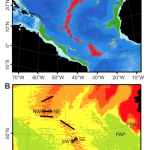[googlemap lat=”2.5479878714713706″ lng=”-32.87109375″ width=”500px” height=”500px” zoom=”4″ type=”G_SATELLITE_MAP”]2.547988,-32.871094[/googlemap]Normally, I wouldn’t discuss an airline disaster here and before I go on let me say my heart goes out to those who lost loved ones in this tragedy. I post this here because I have fielded several questions from friends and family lately about the seafloor, equipment used, and my impression about the possibility of finding the black boxes.
If you don’t know, Air France flight 447 went down in the Atlantic Ocean carrying 228 passengers on June 1st on its way from Rio De Janiero to Paris. How the plane went down is still unknown. Where the plane crashed in the middle of the Atlantic is about 4-5km (2.5-3 miles) in depth. It appears from recent news this likely occured near the Mid-Atlantic Ridge, an underwater moutain chain running the spanse of the Atlantic Ocean and a site of seafloor spreading. if that is the case, and the wreck did not occur over the flat abyssal plains, then greatly reduces the probability of finding the black boxes.
The black boxes themselves are probably rated to about 6000m or 600 atm. The homers on the black boxes are built by the reputable Benthos corporation, a staple in the oceanogaphic work. The signal can be detected from about 1 mile (1.6km) away. This is considerably greater than the typical homer used in research this is closer to about 0.5km.
Current word, is that the French Nautile, a manned submersible commissioned in 1984 and rated to 6000m, and the Victor 6000, a remote operated vehicle, will be arriving shortly on the scene to aid in the search for the black boxes and wreckage.






Air France’s Airbus 340 vertical stabilizer section has been found more or less intact. This is an indicator that it separated in flight and not on impact. It is interesting to note that the vertical stabilizer separated from an US Airways Airbus Industries A300-605R
on take-off in 2001 at JFK killing all aboard. The cause was determined to be (in part) improper rudder input by the co-pilot while dealing with wake turbulence. As a pilot, it’s seems inconceivable that a passenger aircraft whose vertical stabilizer could separate at the connection point in turbulence would be certified as safe. Especially when one considers that in the JFK incident the Airbus was flying under 250 knots, more or less straight and level and the pilot’s only error was excessive rudder input.
Lon Wilmington, NC
To Lon: “Air France’s Airbus 340 vertical stabilizer section has been found more or less intact. This is an indicator that it separated in flight and not on impact.”
An Airbus A320-232 registered D-AXLA operated by XL Airways (Germany) crashed during a test flight on 27 November 2008 off the coast of Canet-Plage (66-France). She has a recorded speed of 263 knots when she impacted the sea in one single piece… and her vertical fin assembly was recovered almost intact floating amongst the debris. See:
http://aviation-safety.net/database/record.php?id=20081127-0
Vertical fin:
http://www.alptraum.us/tail.jpg
But also the same happened during the crash at sea of the Boeing 757-225 operated by Alas Nacionales (Flight ALW 301 departed Puerto Plata for a charter flight to Frankfurt) on 6 February 1996: the vertical fin assembly was also found almost intact.
See:
http://aviation-safety.net/database/record.php?id=19960206-0
On the other hand, the A300-605R of American Airlines has lost his rudder, then her vertical fin assembly, before crashing.
See:
http://aviation-safety.net/database/record.php?id=20011112-0
But this is not the case in the A330-203 crash of Air France which still have her rudder and her vertical stab. It seems to me that jumping to conclusion at this stage isn’t very wise.
Olivier, Toulouse, France
Mr.LON has made some very incorrect statements.
The A300-600 series aircraft was that of American Airlines not US Air and speed is not necessary to create excessive G forces, remember, the aircraft had many discrepancy reports prior to crash and the crew training was unprofessional which helped create an unsafe situation. The Airbus aircraft are Transports not jet fighters and no place for jocks with heavy handed maneuvers.
Tail sections and fuselage body areas are made to separate at a certain G Force during a crash sequence to allow for better chance of survival of passengers. If at any time these G Forces are exceeded in flight same will occur regardless of the aircraft manufacturer. Aircraft regardless of size entering into extremely severe storms will and can end up in tragic circumstances as it appears has happened here, the wise thing to have done was circumnavigate the storm or turn around as point of no return had been reached. The maintenance telemetry can and should not be used as a method of figuring out what happened here, without the Flight Data Recorder and/or Cockpit Voice Recorder to compare sequence of events makes this cause of crash speculative at best. I do not have a close up picture of the hookup segments and pins to see if its in tact or sheared off and did notice that there is no rudder. Tail should be composite and should float.
From what I’ve read about the stabilizer, it’s quite large compared to similar planes, and when the pilot is adjusting the stabilizer, there is no change of resistance from a “slight change” to “major change” input by the pilot… so it is easy to inadvertantly apply more stress than the pilot expects.(Electronic-Fly by wire)
If more of the plane broke up in the air than just the stabilizer, then I would expect more “larger” pieces to be found… but just losing the stabilizer would be enough to lose control of the plane.
I have just stumbled by this site, I am just loving it, its great and interesting.
This was such sad news, and my heart goes out to those that lost family and friends, its funny to hear how many planes have gone down this year and it makes one feel unsafe getting on to a plane these days and you would think that with all the technology that we have there shouldn’t be some many crashes.